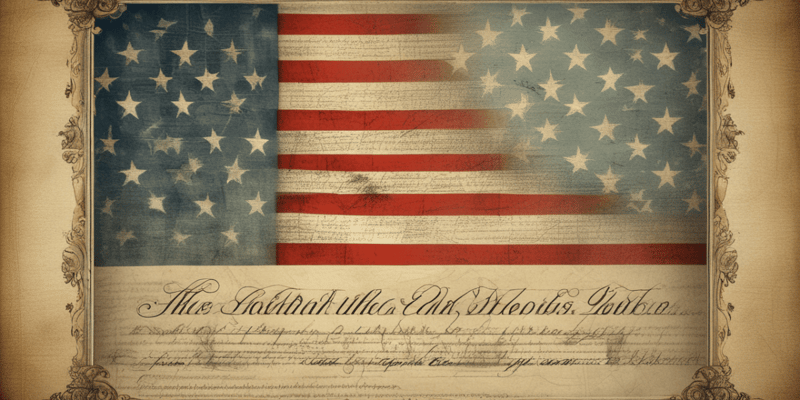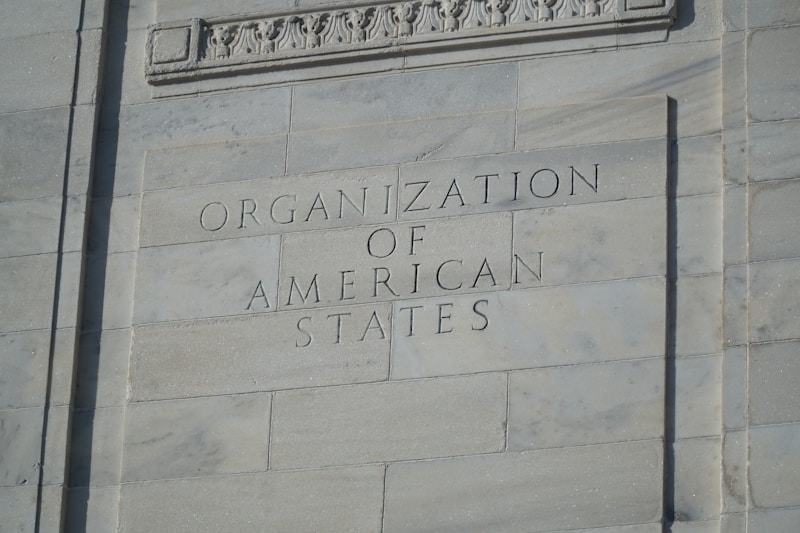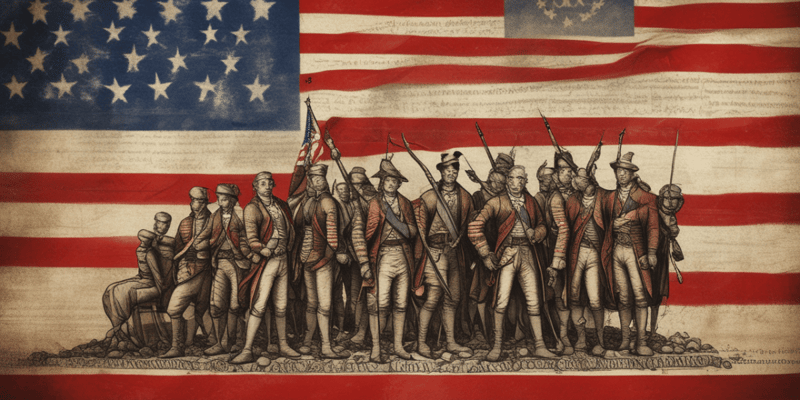69 Questions
In what year was the U.S. Constitution created?
1787
What was the main reason for drafting the Constitution?
To replace the Articles of Confederation
Whose ideas influenced political thought in the American colonies?
John Locke
Why did Britain impose new taxes on the American colonies?
To increase revenue
What was the main reason why many colonists viewed increased taxation as a violation of their rights?
Because they were denied elected representation in Parliament
What was the outcome of the Boston Massacre in 1770?
Tension between colonists and Britain increased
What was the purpose of the Coercive Acts of 1774?
To punish Massachusetts for its defiance
What did the Declaration of Independence reflect?
The Lockean view of individual rights
What was the main problem with the weak central government under the Articles of Confederation?
It lacked the power of taxation
What was the outcome of the Philadelphia convention in 1787?
A new government was formed
What was the main feature of the Virginia Plan proposed at the Philadelphia convention?
Representation based on population
What was the consequence of the lack of a national currency under the Articles of Confederation?
Interstate commerce was crippled
What is the power of the legislative branch of government?
Making laws
What is the purpose of the Supremacy Clause?
To establish federal laws as supreme
What was required for the Constitution to enter into force?
Ratification by 9 of the 13 states
What was the main point of contention between the Federalists and Anti-Federalists?
The power of the federal government
What is the purpose of The Federalist Papers?
To argue in favor of the Constitution and federalism
What was the main feature of the New Jersey Plan?
A unicameral national legislature with equal representatives from each state
What was the main issue of contention between the Virginia and New Jersey Plans?
The number of representatives from each state
What was the purpose of the Three-Fifths Compromise?
To resolve the dispute over congressional apportionment
What is the main function of the legislative branch according to the Constitution?
To make laws
How many branches of government are established by the Constitution?
Three
What percentage of approval is required to ratify a proposed amendment to the Constitution?
Three-quarters
Which of the following was NOT one of the primary concerns addressed by the first ten amendments?
Limitations on state governments
How many amendments were proposed by Congress in September 1789?
Twelve
What were the Thirteenth, Fourteenth, and Fifteenth Amendments primarily concerned with?
Providing for the protection of civil liberties and civil rights
Which of the following methods may be used to ratify a proposed amendment to the Constitution?
Either state legislatures or state ratifying conventions
What was the primary concern of the Anti-Federalists that led to the proposal of the first ten amendments?
Protecting individual liberties
How many of the proposed twelve amendments were ratified by state legislatures?
Ten
The American colonies declared independence from British rule on July 2, 1775.
False
The British army surrendered at Yorktown, Virginia, in October 1780.
False
The Articles of Confederation required the approval of a majority of the thirteen colonies.
False
The national government under the Articles of Confederation had the power of taxation.
False
The Philadelphia convention in 1787 resulted in the revision of the Articles of Confederation.
False
The Virginia Plan proposed a unicameral national legislature.
False
The national government under the Articles of Confederation could raise a standing army or navy.
False
The national currency was widely accepted by citizens across states under the Articles of Confederation.
False
The executive branch of government is responsible for making laws.
False
The power of the federal government is specified in the Constitution.
True
Federal laws supersede state laws in areas of conflict.
True
The Constitution was ratified by unanimous consent of all states.
False
The Federalist Papers were written by Alexander Hamilton, John Jay, and James Madison to argue against ratification.
False
The Constitution may be amended by a simple majority in Congress.
False
The Constitution has undergone no changes since its adoption in 1787.
False
Article V of the Constitution provides for the proposal of amendments by Congress and the states.
True
The New Jersey Plan provided for a bicameral national legislature with an equal number of representatives from each state.
False
The Great Compromise called for a unicameral legislature with representation based on each state’s population.
False
Under the Three-Fifths Compromise, enslaved people were counted as full citizens of each state.
False
The Constitution divides the national government into four branches.
False
The legislative branch is comprised of the House of Representatives and the Senate.
True
The Constitution prohibits the abolition of the foreign slave trade indefinitely.
False
The Constitution requires states to return freedom seekers who come to their states for refuge.
True
The Constitution establishes the Supreme Court of the United States as the highest court in the land.
True
The U.S. Constitution was created in 1777.
False
The U.S. Constitution is the oldest written constitution remaining in effect.
True
John Locke was a 19th century English political philosopher.
False
The British Parliament imposed a series of new taxes, including direct taxation, on the American colonies to increase revenue after the Seven Years' War.
True
The Constitution was created through a series of compromises among factions that favored a strong state government over strong federal government.
False
According to John Locke, people possess natural rights granted by God, including the right to life and property.
True
The British gained ownership of all American land east of the Mississippi River after the French and Indian War.
False
The Articles of Confederation provided a strong central government.
False
Three-fourths of state legislatures or state ratifying conventions are required to ratify a proposed constitutional amendment.
False
The Bill of Rights consists of the first twelve amendments to the Constitution.
False
The Thirteenth, Fourteenth, and Fifteenth Amendments were primarily concerned with the protection of individual liberties.
False
State legislatures ratified all twelve proposed amendments in 1789.
False
The Constitution was amended after the American Civil War to address the rights of freed slaves.
True
The Constitution may be amended by a national convention or Congress.
True
The Bill of Rights protects the rights of freed slaves.
False
The Constitution requires unanimous approval of state legislatures to ratify a proposed amendment.
False
Study Notes
The U.S. Constitution
- The U.S. Constitution was created in September 1787 and is the oldest written constitution still in effect.
- The Constitution was drafted during a period of ineffective national government under the Articles of Confederation.
- The document was created through a series of compromises among factions that favored a strong federal government, states with different economic interests, and those concerned about the distribution of power among states.
Influences on the Constitution
- The writings of John Locke, a 17th-century English political philosopher, greatly influenced political thought in the American colonies.
- Locke asserted that people possess natural rights granted by God, including the right to life, liberty, and property, which lead people to form a government to protect their common interests.
The American Revolution
- The Seven Years' War (1756-1763) led to Britain's gain of ownership of all American land east of the Mississippi River, but also forced Britain to the brink of bankruptcy.
- To increase revenue, the British Parliament imposed taxes on the American colonies, which led to colonists viewing increased taxation as a violation of their individual rights and the social contract.
- The Boston Massacre (1770) and the Boston Tea Party (1773) exacerbated tension between colonists and Britain.
- The Declaration of Independence (1776) reflected the Lockean view of the colonists' right to self-governance and the individual right to "Life, Liberty, and the pursuit of Happiness."
The Articles of Confederation
- The Articles of Confederation provided for a weak central government and strong self-governing states.
- The national government lacked the power of taxation, a standing army, or navy, and was prohibited from imposing tariffs or regulating interstate commerce.
- The Articles of Confederation required the approval of all thirteen colonies and were ratified in 1781.
The Constitutional Convention
- The Constitutional Convention was held in 1787 to revise the Articles of Confederation, but the delegates decided to scrap the Articles and form a new government.
- Two competing plans, the Virginia Plan and the New Jersey Plan, were proposed for the national government.
- The Great Compromise resolved the debate over representation in the national legislature, providing for a bicameral legislature with representation in the House of Representatives based on population and equal representation in the Senate.
The Constitution
- The Constitution divided the national government into three branches: the legislative, executive, and judicial.
- The Constitution established a federal system of government, dividing power between the national government and the states.
- The Constitution has undergone 27 amendments since its adoption, with the first 10 amendments collectively known as the Bill of Rights.
Ratification of the Constitution
- The Constitution required the ratification of nine out of the thirteen states to enter into force.
- Delegates to state ratification conventions debated the merits of the Constitution, with Federalists favoring ratification and Anti-Federalists opposing it.
- The Constitution came into effect on March 4, 1789, after New Hampshire became the ninth state to ratify it.
The Creation of the U.S. Constitution
- The U.S. Constitution was created in September 1787, making it the oldest written constitution still in effect today.
- The Constitution was drafted by the Framers during a period of ineffective national government under the Articles of Confederation.
- The document was created through a series of significant compromises among factions with differing views on federal government, state governments, and individual rights.
Influences on the Constitution
- The writings of John Locke, a 17th-century English political philosopher, greatly influenced political thought in the American colonies.
- Locke asserted that people possess natural rights granted by God, including the right to life, liberty, and property.
- Locke's ideas conflicted with the long-held belief in England and most of Europe that God had granted temporal power to a hereditary monarchy.
The American Revolution and the Articles of Confederation
- The American Revolution was sparked by Britain's imposition of new taxes on the American colonies, denying them elected representation in Parliament.
- The Declaration of Independence, signed on July 4, 1776, reflected the Lockean view of the colonists' right to self-governance and individual rights.
- Following the American Revolution, the Articles of Confederation were ratified in 1781, providing for a weak central government with limited powers.
The Problems with the Articles of Confederation
- The national government lacked the power of taxation, leading to financial difficulties and an inability to raise a standing army or navy.
- The national currency was worthless, and interstate commerce was crippled due to the lack of regulation and tariffs.
- The national government failed to protect American ships from piracy and could not control the country's western frontier.
The Constitutional Convention
- In 1787, a convention was called to revise the Articles of Confederation, but the delegates decided to scrap the document and create a new government.
- Two competing plans were proposed: the Virginia Plan, which provided for a bicameral national legislature with representation based on population, and the New Jersey Plan, which provided for a unicameral national legislature with equal representation from each state.
- The Great Compromise was proposed, which called for a bicameral legislature with representation in the House based on population and equal representation in the Senate.
The Three-Fifths Compromise
- The delegates debated whether enslaved people should count towards the population of each state for purposes of congressional apportionment.
- The Three-Fifths Compromise resolved the dispute, stating that each state's population would be considered the total number of free citizens plus three-fifths of the total number of slaves.
The Structure of the Constitution
- The Constitution divides the national government into three branches: the legislative, executive, and judicial.
- The legislative branch, comprised of the House of Representatives and the Senate, has the power to make laws.
- The executive branch, headed by the President, is responsible for enforcing laws.
- The judicial branch, comprised of the Supreme Court and lower federal courts, tries cases arising under federal laws.
Ratification of the Constitution
- The Constitution was approved by the Constitutional Convention in September 1787 but required ratification by nine out of thirteen states to enter into force.
- The document was ratified by New Hampshire in June 1788, followed by Virginia and New York, making the Constitution effective on March 4, 1789.
The Bill of Rights
- In 1789, Congress proposed twelve amendments to the Constitution, primarily to address concerns of Anti-Federalists related to individual liberties and federal power.
- State legislatures ratified ten of the twelve proposed amendments, collectively known as the Bill of Rights.
Amendments to the Constitution
- The Constitution has been amended twenty-seven times since its ratification in 1789.
- Article V provides for the proposal and ratification of amendments, requiring a two-thirds approval in Congress or a national convention, followed by approval by three-quarters of state legislatures or state ratifying conventions.
Learn about the creation of the US Constitution in 1787, the compromises made by the Framers, and the reasons behind its drafting. Discover the significance of this document in American history.
Make Your Own Quizzes and Flashcards
Convert your notes into interactive study material.
Get started for free



